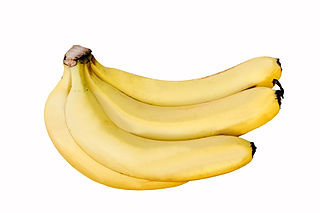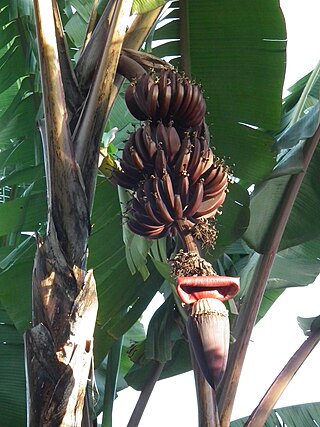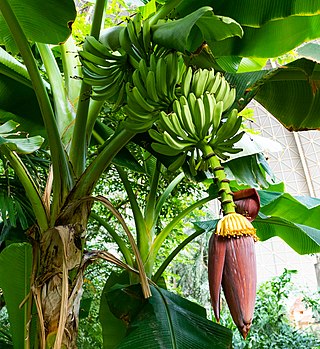
A banana is an elongated, edible fruit – botanically a berry – produced by several kinds of large herbaceous flowering plants in the genus Musa. In some countries, cooking bananas are called plantains, distinguishing them from dessert bananas. The fruit is variable in size, color, and firmness, but is usually elongated and curved, with soft flesh rich in starch covered with a rind, which may have a variety of colors when ripe. The fruits grow upward in clusters near the top of the plant. Almost all modern edible seedless (parthenocarp) bananas come from two wild species – Musa acuminata and Musa balbisiana. Most cultivated bananas are M. acuminata, M. balbisiana, or hybrids of the two.

Cooking bananas are a group of starchy banana cultivars in the genus Musa whose fruits are generally used in cooking. They are not eaten raw and generally starchy. Many cooking bananas are referred to as plantains or 'green bananas'. In botanical usage, the term "plantain" is used only for true plantains, while other starchy cultivars used for cooking are called "cooking bananas". True plantains are cooking cultivars belonging to the AAB group, while cooking bananas are any cooking cultivar belonging to the AAB, AAA, ABB, or BBB groups. The currently accepted scientific name for all such cultivars in these groups is Musa × paradisiaca. Fe'i bananas from the Pacific Islands are often eaten roasted or boiled, and are thus informally referred to as "mountain plantains", but they do not belong to any of the species from which all modern banana cultivars are descended.

Musaceae is a family of flowering plants composed of three genera with about 91 known species, placed in the order Zingiberales. The family is native to the tropics of Africa and Asia. The plants have a large herbaceous growth habit with leaves with overlapping basal sheaths that form a pseudostem making some members appear to be woody trees. In most treatments, the family has three genera, Musa, Musella and Ensete. Cultivated bananas are commercially important members of the family, and many others are grown as ornamental plants.

Musa is one of three genera in the family Musaceae. The genus includes 83 species of flowering plants producing edible bananas and plantains. Though they grow as high as trees, banana and plantain plants are not woody and their apparent "stem" is made up of the bases of the huge leaf stalks. Thus, they are technically gigantic herbaceous plants. Musa species are used as food plants by the larvae of some Lepidoptera species, including the giant leopard moth and other Hypercompe species, including H. albescens, H. eridanus, and H. icasia.

Cavendish bananas are the fruits of one of a number of banana cultivars belonging to the Cavendish subgroup of the AAA banana cultivar group. The same term is also used to describe the plants on which the bananas grow.

The Goldfinger banana (FHIA-01) is a banana cultivar developed in Honduras. The cultivar, developed at the Honduran Foundation for Agricultural Research (FHIA) by a team of scientists led by Phillip Rowe and Franklin Rosales, has been bred to be pest-resistant and crop-yielding.

Red bananas are a group of varieties of bananas with reddish-purple skin. Some are smaller and plumper than the common Cavendish banana, others much larger. When ripe, raw red bananas have a flesh that is creamy to light pink. They are also softer and sweeter than the yellow Cavendish varieties, some with a slight tangy raspberry flavor and others with an earthy one. Many red bananas are exported by producers in East Africa, Asia, South America, and the United Arab Emirates. They are a favorite in Central America as a form of aphrodisiac juice, along with being a favourite in India to promote fertility but are sold throughout the world.

Rhino Horn bananas, also called Rhino Horn plantains or African Rhino Horn, are hybrid banana cultivars from Africa. It produces strongly curved and elongated edible bananas which can grow to a length of two feet, the longest fruits among banana cultivars.

Musa acuminata is a species of banana native to Southern Asia, its range comprising the Indian Subcontinent and Southeast Asia. Many of the modern edible dessert bananas are from this species, although some are hybrids with Musa balbisiana. First cultivated by humans around 10 kya, it is one of the early examples of domesticated plants.

The Blue Java is a hardy, cold-tolerant banana cultivar known for its sweet aromatic fruit, which is said to have an ice cream-like consistency and flavor reminiscent of vanilla. It is native to Southeast Asia and is a hybrid of two species of banana native to Southeast Asia—Musa balbisiana and Musa acuminata.

Saba banana is a triploid hybrid (ABB) banana cultivar originating from the Philippines. It is primarily a cooking banana, though it can also be eaten raw. It is one of the most important banana varieties in Philippine cuisine. It is also sometimes known as the "cardaba banana", though the latter name is more correctly applied to the cardava, a very similar cultivar also classified within the saba subgroup.

Fe'i bananas are cultivated plants in the genus Musa, used mainly for their fruit. Unlike most other cultivated bananas they are diploids of the AA-type. They are very distinct in appearance and origin from the majority of bananas and plantains currently grown. Found mainly in the islands of the Pacific, particularly French Polynesia, Fe'i bananas have skins which are brilliant orange to red in colour with yellow or orange flesh inside. They are usually eaten cooked and have been an important food for Pacific Islanders, moving with them as they migrated across the ocean. Most are high in beta-carotene.

Lady Finger bananas are diploid banana cultivars originating in Malaysia or Indonesia, belonging to the Sucrier subgroup of the AA banana cultivar group. Lady Finger banana is the most widely cultivated AA cultivar and is one of the world’s most popular local bananas. Banana fruits are finger-sized, thin skinned, and deliciously sweet.

Lakatan bananas, also spelled Lacatan, are diploid banana cultivars from the Philippines. It is one of the most common banana cultivars in the Philippines, along with the Latundan and Saba bananas.

Señorita bananas are diploid cultivars of the banana Musa acuminata originating in the Philippines. They are very small stout bananas which, like all bananas belonging to the AA cultivar group, are known for being extraordinarily sweet.

Thai banana is a banana cultivar originating from Thailand, belonging to the triploid ABB banana cultivar group. This banana cultivar is one of the most important banana fruits in tropical and subtropical regions worldwide. Thai bananas contain many nutrients and are often eaten when ripe or prepared into many other dishes. Almost all parts of the Thai banana tree have useful uses for humans.

Musa × paradisiaca is a triploid cultivar of banana, belonging to the Cavendish banana subgroup, originating as the hybrid between Musa acuminata and Musa balbisiana, cultivated and domesticated by human very early. Most cultivated bananas and plantains are cultivars of this hybrid. Linnaeus originally used the name M. paradisiaca only for plantains or cooking bananas, but the modern usage includes hybrid cultivars used both for cooking and as dessert bananas. Linnaeus's name for dessert bananas, Musa sapientum, is thus a synonym of Musa × paradisiaca.
Masak Hijau bananas are triploid banana cultivars from Malaysia. It is a member of the commercially important Cavendish banana subgroup. It is a popular banana cultivar in Southeast Asia and the West Indies.

Cardava bananas, also spelled cardaba or kardaba, is a triploid hybrid (ABB) banana cultivar originating from the Philippines. It is primarily a cooking banana, though it can also be eaten raw. It is commonly confused with the more ubiquitous and closely related saba banana because they are used identically in traditional Filipino cuisine. Their common names can be interchanged in everyday usage though they are different cultivars.




















